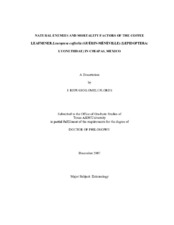| dc.description.abstract | Through field surveys and laboratory experiments, this study assessed in part the
impacts of host plant, natural enemies, and weather variables on coffee leafminer
Leucoptera coffeella distribution and abundance at two elevations and two rainfall levels
in coffee farms in Chiapas, Mexico. In addition, a checklist of Neotropical coffee
leafminer parasitoids was assembled from field collections and literature review.
Coffee leafminer field incidence was positively correlated with leaf nitrogen content and
age, but in laboratory experiments coffee leafminers grew larger, developed faster, and
had higher survivorship on leaves with moderate (2.9±0.01%) versus low (2.5±0.04%)
or high (3.4±0.01%) nitrogen level, and on tough versus soft leaves. Ovipositional
preference was not generally for leaves that maximized offspring performance. Coffee
leafminer incidence was higher during the rainy versus dry season, and at low versus
high elevation. Shade cover reduced ambient temperatures within coffee farms, but did
not significantly affect coffee leafminer incidence. The coffee leafminer predator complex included 16 morphospecies, ~88% of
them ants (Formicidae), and contributed >58% of real mortality. Predation rates were
higher at high versus low elevation, and under high versus low rainfall. Predation was
the main source of coffee leafminer mortality throughout the year, and was highest
during the rainy season, when coffee leafminer incidence was highest.
Neotropical coffee leafminer parasitoids included 23 species of Eulophidae and
seven of Braconidae. In Chiapas, 22 larval parasitoid morphospecies were collected. Egg
and pupal parasitoids were not recovered. Parasitism accounted for <10% of real
mortality, and rates were 8-10-fold higher at low versus high elevation. Parasitism rates
were not significantly influenced by temperature or rainfall.
Coffee leafminer oviposited mostly during the night, and less under low versus
high temperatures. Average monthly temperature minima, which occur during the night,
were generally lower at high (~18 oC) versus low (~20 oC) elevation farms. The
incidence and abundance of coffee leafminer may differ between elevations due to
differences in temperature, because at high elevation lower temperatures likely reduced
coffee leafminer oviposition, and may have increased its mortality rate as a consequence
of longer development time and exposure to natural enemies. | en |


